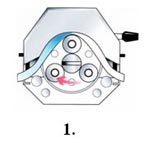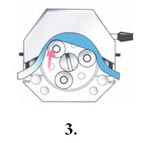How does a peristaltic pump work?
How does a peristaltic pump work?
Similar to the way a human body pumps blood, food and oxygen, a peristaltic pump uses the process of peristalsis to pump products through a hose. The hose is wound around a rotor that compresses a section of the hose almost flat. When the rotor releases the compression, the hose returns to its round shape, consequently creating a partial vacuum that refills the hose. This compression creates a seal and, as the rotor turns, any product on the discharge side of the rotor is impelled forward and out of the pump. The combination of the suction and the discharge action results in a self-priming positive displacement pump.
 A peristaltic pump head consists of only two parts: the rotor and the housing. The peristaltic tubing is placed in the tubing bed – between the rotor and housing — where it is occluded (squeezed).
A peristaltic pump head consists of only two parts: the rotor and the housing. The peristaltic tubing is placed in the tubing bed – between the rotor and housing — where it is occluded (squeezed).
 The rollers on the rotor move across the tubing, pushing the fluid. The tubing behind the rollers recovers its shape, creates a vacuum and draws fluid in from behind it.
The rollers on the rotor move across the tubing, pushing the fluid. The tubing behind the rollers recovers its shape, creates a vacuum and draws fluid in from behind it.
 A “pillow” of fluid is formed between the rollers. This is specific to the ID of the tubing and the geometry of the rotor. The flow rate is determined by multiplying speed by the size of the pillow. This pillow stays fairly constant, except with very viscous fluids.
A “pillow” of fluid is formed between the rollers. This is specific to the ID of the tubing and the geometry of the rotor. The flow rate is determined by multiplying speed by the size of the pillow. This pillow stays fairly constant, except with very viscous fluids.
Request a callback Download Brochure
Categories: Peristaltic Pumps



